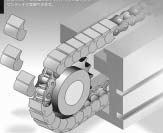Calculation of Chain Stress
In general, initially, tentatively establish the chain dimension for being utilized referring to “Tentative determination of chain size”. Then, obtain “Theoretical chain tension (T)” (P213) for the tentatively determined chain, and multiply the worth by “Speed coefficient (K)”, to acquire “Substantial chain stress (Ta)”. For safety, the considerable chain stress must be lower than the “maximum allowable tension” stated during the table of dimensions of respective chains. Consequently, the problem below must be happy.
Safety condition of chain tension
Substantial chain tension (Ta) =Theoretical chain tension (T) ×Speed coefficient (K)
Significant chain tension (Ta) <Maximum allowable tension
If this ailment is just not satisfied, pick a bigger chain by one dimension and re-calculate.
Tentative determination of chain size
qDetermine the mass (fat) per unit length of parts such as chain and attachment ωc (kg/m or kgf/m) assuming that it’s 10 % in the mass (excess weight) with the conveyed object ω1 (kg/m or kgf/m).
wIn reference to the calculation formulas on, get “Theoretical chain stress (T)” (kN or kgf) and “Speed coefficient (K)”, and determine “Substantial chain stress (Ta)” (kN or kgf).
eIn reference to your table of dimensions of chains,identify the minimal chain, whose “maximum allowable tension” is larger compared to the “Substantial chain tension (Ta)”, and regard it as “tentatively made a decision chain”.
Worth of velocity coefficient (K)
The speed coefficient (K) expresses the severity of operation issue in accordance to your traveling pace of chain since the problem gets to be severer because the traveling pace of chain becomes higher.
Multiply “Theoretical chain tension (T)” by “Speed coefficient (K)” to acquire “Substantial chain tension (Ta)”.
When you style different conveyor methods utilizing smaller conveyor chains, the following essential problems should be happy.
a. Chain stress: The actual tensile strength in operation have to be appreciably lower than the specified strength of your chain.
b. Strength of loaded elements of chain: The real loads utilized to attachments, such as rollers of base chain, top rollers, side rollers, and so on. in operation must be considerably smaller sized than the strength of these parts.
c. Wear existence of chain: Lubrication conditions to make certain the dress in daily life of chain need to be fulfilled.
d. Sag adjustment of chain: The sag of your chain should be stored optimum by stress adjusters, take-up  units, guides, and so forth.
units, guides, and so forth.
e. Other individuals: Suitable measures are taken to avoid rail dress in, machine vibration and also other complications.
The following complement the above.